Intro
Under the successful reign of Philip the Fair, the small Capetian monarchy grew into a respected dynasty that rules the richest and most populous kingdom in Europe. A reign marked by two major affairs:the conflict with the papacy and the trial of the Templars. But which also sees an increase in royal power, a development of the administration and an extension of the royal domain.
The reign of Philip III the Bold
The reign of Philip III the Bold
Philippe III, who was nicknamed le Hardi, was the son of Saint Louis and Marguerite de Provence. As was now the rule, he succeeded his father, who died in Tunis, whom he had accompanied during the eighth crusade. Philippe III takes his name from bold by his valor in combat, but he proves to be submissive and weak in the face of the strong personalities of his entourage, in particular his uncle Charles of Anjou. Through family inheritance, he brought Poitou, Auvergne and the county of Toulouse into the royal domain. He showed wisdom in keeping in place the political and administrative staff appointed by his father. But he was also drawn into the conflict between his uncle Charles of Anjou and Pierre III of Aragon for the possession of Sicily. Philippe supported the policy of his uncle, driven out of Sicily after the massacres of Sicilian Vespers in 1282. The pope excommunicated Peter III of Aragon considered the instigator of the massacre and gave his kingdom to Charles de Valois, son of Philippe le Bold. He died in Perpignan in 1285, while leading an expedition against the Aragonese. The reign of Philippe III constitutes a transitional reign between that of his father Saint Louis and his son Philippe IV le Bel.
Consecration of Philip III the Bold

Great Chronicles of France
France is getting richer
During the sixty years that separate the beginning of the reign of Louis VIII to the end of that of Philip III, the face of France has changed profoundly. Progress in the movement of people and goods, development of trade and market prosperity, urban development, these are the main aspects of the period. People get used to living better. In more comfortable houses, equipped with a built chimney, the first pieces of furniture make their entrance. As the granaries are full and there is no fear of famine, more attention is paid to the quality of food:wine, meat, fish and spices, bought at fairs, are consumed more frequently. The clothing is the subject of attentive care:we look for heavy fabrics in warm or violent colors, we show elegance in the arrangement of the costume. The cities, whose population continues to grow and which are surrounded by walls separating them from the neighboring “flat country”, are the site of the most spectacular transformations. As the consumption of goods increased and buyers became more numerous and wealthier, certain professions such as drapers and water merchants in Paris grew stronger and took on new importance; in all the towns, craftsmen specializing in the manufacture of the same product come together and unite within the framework of corporations. With incomes incomparably higher than those of the craftsmen, the rich bourgeois, who made their fortunes in the trade of luxury goods, had stone "hotels" built in the center of the cities. Cultivated and ambitious, they devote part of their time and income to the affairs of the urban community. They most often monopolize the municipal functions:mayor, alderman, consul...
The 13th century smile
There is in the French civilization of the thirteenth century something flourishing, both smiling and strong, which is the sign of a great era. The facades and capitals, which the Romanesque artists had populated with disturbing beasts and monsters, are now lit up by the radiant faces of angels or Christs. In the oratories, like the Sainte-Chapelle, or in the vast cathedrals, like Reims or Notre-Dame, everywhere elegance is combined with the power of design, with the bursting of the creative impulse. A serene fullness emanates from these strong architectures, symbolizing the harmony found between intelligence and sensitivity, between the divine and the things of the earth.
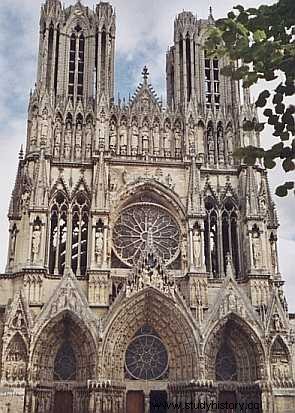
Cathedral of Our Lady of Reims
The reign of Philip IV the Fair
Philip the Fair:a centralizing king
Philippe IV ascended the throne in 1285. Of the one called Philippe le Bel, Bishop Bernard Saisset, his enemy, could affirm:"Our king is like the Grand Duke, the most beautiful of birds, but which is worthless. He only knows how to stare at people without speaking. » Yet this king of marble, this secret king who presided over assemblies without saying a word knew how to make decisions. He first listened to the opinion of each other and then he decided without appeal. No one more than he strove to increase the monarchical powers and to have them respected throughout the kingdom. Having been consecrated at Reims, like his predecessors, he considered himself the depositary of a sacred power and considered that he had to render an account only to God. He demanded of the lords of the kingdom, his vassals, that they obey and submit with docility to his sovereign decisions; of the feudal contract that bound him to them, he retained their obligations and paid little heed to his own.
Edward I pays homage to Philippe le Bel
As is customary for the vassal and his overlord, King Edward I of England, who owns the Duchy of Guyenne, gives the kiss during the ceremony of homage to the King of France.

The conflict with the papacy
Seeking to break down what could be an obstacle to the exercise of his authority, it was inevitable that Philip would come into conflict with the pope:supreme head of the Church, the latter claimed to hold a power superior to that of the king, and considered himself “emperor of the world”, he did not hide his desire to see the birth of a unified Christian empire under the aegis of a religious sovereign. The disagreement between the monarchy and the papacy burst on a question of money, because Philippe did not accept that the incomes of the Church of France go to enlarge the treasure of the pope in Italy. In 1296, Philip imposed a tax on the clergy. The Pope retaliates and threatens the King of France with excommunication. In 1302, Philippe brought together for the first time the assembly of the Three States (ancestor of the general states), he then claimed the deposition of the pope by a council. The conflict reached its climax in 1303, with Guillaume de Nogaret arresting Pope Boniface VIII. After the death of Pope Benedict XI, Philippe le Bel appointed the Archbishop of Bordeaux, Bertrand de Got, who became pope in 1305 under the name of Clement V and who settled in Avignon in 1308. His successors remained there until in 1376. In this way, the king managed to place the Church in the dependence of the crown of France and to detach the papal influence on the Christian kings.
The Anagni episode
In 1303, Philippe le Bel then decided, on the advice of Guillaume de Nogaret, to have the Pope arrested. The latter goes to the small town of Anagni where the Pope was staying, he then summons the pontiff to follow him to Lyon. Boniface VIII would have defended himself thus:"Here is my head! I, legitimate vicar of Christ, I will suffer from being condemned, deposed and even martyred for the freedom of the Church" by treating Guillaume de Nogaret as "son of Cathar". A probably false legend claims that Nogaret even slapped the pope. The attackers are however forced to leave the city after two days. But deeply humiliated, Boniface, already 60 years old, died a month later.

Boniface VIII
The artisans of royal policy
After settling the problems that opposed him to the papacy, Philip wanted to put his government in order. Relying on the reforms that had been initiated by Saint Louis, he reorganized it, divided it into permanent sections and made it a veritable general administration of the kingdom. The king's court was thus divided into three distinct parts:
- Parliament :Certain barons, knights and prelates were entrusted with the task of administering justice in the name of the king. Their union formed the Parliament, or Supreme Court of Justice, which settled in Paris. To help and advise these courtiers in their task, professionals were appointed to their side with the necessary legal knowledge. Such was the origin of the lawyers, some of whom (Guillaume de Nogaret, Enguerrand de Marigny) became the monarch's direct advisers, wielding powers of which most vassals were deprived.
- The King's Council :The members of the royal family and the greatest lords discussed all the administrative and political problems which arose in the country.
- The Audit Bench :She dealt with the management of public finances; it was open to the Parisian bourgeois, including two Italians, nicknamed Biche and Mouche, who displayed an impressive activity in the collection of public funds.
The king's financial difficulties
As the years passed, Philippe le Bel's financial needs increased. How to collect more money, how to get new resources? It wasn't that simple, really, because the king was far from doing exactly what he wanted. The provincial petty nobility and the urban bourgeoisie resented royal agents encroaching on their rights. Under these conditions, regular income could not be counted on, and loans did not always succeed in making up for the deficit which was growing between expenditure and income. It was therefore often necessary to have recourse to more expeditious means, the devaluation of the currency for example. That which was decided in 1306 had the direct consequence of tripling Parisian rents. Furious, the people of the capital rose up. The king had to take refuge in the tower of the Temple, and the Council, meeting urgently, decided "that the rents should continue to be paid at their old real rate." The sovereign got off with finding money elsewhere. He turned to the Jews first, then to the Templars.
Philip IV surrounded by his heirs and his lawyers

The extension of the royal domain
To what use did Philippe le Bel intend these sums of money, always insufficient, which he tried to obtain by all means? For the most part, to war. Two conflicts marked the reign. In Guyenne, the tension only rarely subsided with this too powerful vassal that was the King of England. But it was above all Flanders that Philip tried to annex. The discord between the Count of Flanders and the King of France was coupled with a conflict opposing in the large "draping" cities (those where fabrics and sheets were produced) the merchant bourgeoisie, who spoke French, and the people of workers, of Flemish culture. Having imprisoned the Count of Flanders after luring him to Paris by trickery, Philip the Fair occupied Flanders in 1300. Two years later, during the Matins of Bruges, the Flemish population massacred the French garrison at the foot of their bed . To punish them, Philip sent an army to Flanders which, against all odds, was defeated on July 11, 1302 at Courtrai by the Flemish insurgents:"The beauty and power of such a strong army fell into the dung pit , writes a chronicler from Ghent, and there the glory of the French became a rot covered with vermin” . Of course, we couldn't stop there. In August 1304 in Mons-en-Pévèle, the king, although having been knocked down from his horse and having had to fight with an ax to free himself, led his army towards victory. By the Peace of Athis, he was able to annex French-speaking Flanders, along with the cities of Lille and Douai. The count of Flanders had to renew his homage to the king of France, but until the end of the reign, and even beyond, the county of Flanders was watched militarily, because the revolt did not stop rumbling there. Thus Philippe le Bel had continued the permanent policy of the Capetians of enlarging the royal domain.
Kortrijk defeated
Also known as the Battle of the Golden Spurs, the Battle of Kortrijk saw the birth of a unique event in military history:infantrymen prevailed over horsemen.
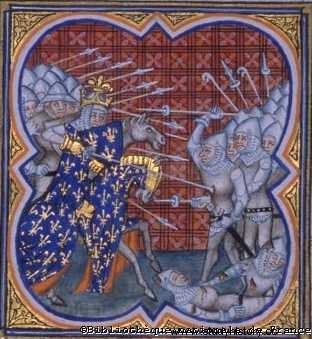
(National Library of France)
The fall of the Templars
The Templars
The Order of the Temple is the most prestigious and the most famous order of chivalry of the Middle Ages. He was born in the Holy Land in 1119, after the first Crusade, on the initiative of the Champagne knight Hugues de Payns who wanted to protect pilgrims going to Jerusalem. It was made official by the Council of Troyes, nine years later at the request of Bernard de Clairvaux. The order takes its name from Solomon's temple in Jerusalem, where it had its headquarters in its early days. In addition to the protection of pilgrims, the Templars are responsible for the protection of the Holy Places in Palestine. They depend entirely on the pope, and therefore enjoy total independence from the kings. The rule of the order is written by Bernard of Clairvaux (Saint Bernard), one of the most influential figures of his time. He associates the rule of Saint Benedict with the new concept of monk-soldier. The Templars are dedicated to chastity, poverty and obedience, a Grand Master is at the head of the order. In mainland France, they set up numerous commanderies intended for the recruitment of new knights and for the accommodation of invalids. In the Holy Land, they build large fortresses with powerful and efficient architecture:the kraks, such as Mount Tabor in Palestine. From the beginning of the 13th century, the Temple had a considerable army, much larger than that which a king of Christendom could have raised. Driven by exemplary faith and courage, the Templars demonstrated countless feats of arms, despite the disaster of the Battle of Hattîn in 1187.
Templar Seal
The history of the order of the temple is very enigmatic. Many historians and authors continue to tell us about their approach to enigmas, mysteries, esotericism, and the tradition of the order of the temple. Many legends also enrich the mythology around the famous Templar treasure.
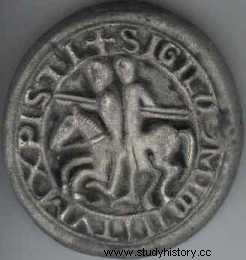
Disputing the order
After the Eighth Crusade and the death of Saint Louis, the Frankish positions in the Holy Land passed definitively into the hands of the Muslims, despite the heroic resistance of the Templars during the siege of Saint-Jean d'Acre in 1291. Very quickly, the The order loses sight of the reconquest of the Holy Places and most of the soldier monks have become loan sharks. It must be said that excessive donations made the order extremely wealthy. The Temple soon became manager of the property of the Church and of the kings of the West. From there, public opinion begins to question the legitimacy of the order. Humility and poverty gave way to arrogance and lust. Philippe le Bel, in conflict with the papacy and in search of funds, is frustrated to see on his kingdom these knights exempt from taxes and dependent only on the pope. For a long time already, there has been talk of a merger of the Temple with the competing order of the Hospitallers, in order to obtain sufficient strength to launch a new crusade. But the Grand Master Jacques de Molay has only one unavowable goal:to preserve his position within the order.
The trial of the Templars
In 1307, at the request of Philippe le Bel, Guillaume de Nogaret led a veritable police raid. At dawn on October 13, the seneschals and bailiffs arrested the 140 Templars of Paris. They are handed over to the Dominican inquisitors, who make them confess under torture, crimes such as sodomy or the desecration of the cross. For the king, it is indeed a confirmation of the corruption and impiety of the order. Faced with this arrest, the pope sees it as an offense to his power, but he is soon presented with several knights who describe to him the crimes committed by the Temple. For the defenders of order, it is obvious that these confessions were extracted under torture. But in 1312, Clement V ordered the suppression of the order. The goods of the Templars are transferred to the Hospitallers, and King Philippe manages to gain a significant share. After seven years of imprisonment, the Grand Master Jacques de Molay and his partner Geoffroy de Charnais are condemned to the stake after an unfair trial. Legend has it that at the moment of succumbing to the flames, Jacques de Molay launched a curse on the pope and the king, inviting them to join him in death within a year. The curse was to prove, Clement V died a month later, Philippe le Bel and Guillaume de Nogaret died within the year.
The Grand Master's Curse
“Pope Clement…Knight Guillaume de Nogaret…King Philippe…within a year, I summon you to appear before the tribunal of God to receive your just punishment!…Accursed! Cursed! you will all be cursed until the thirteenth generation of your races!…”

The Cursed Kings
The Iron King's Legacy
It is thanks to the influence of the kingdom of France on the papacy, that Philippe le Bel, who is also called the iron king, was able to dismantle the Templars. But this tragic episode should not make us forget what this unloved king during his lifetime was able to bring to the kingdom of France. He detached himself from papal influence, granted freedom to the serfs, gave voice to the people (meeting of the Assembly of States), his measures for citizenship allowed the weakening of the great feudal lords. He also gave the country the most modern administration of its time and ensured relative peace during his reign. Finally he attached himself to the future of his dynasty:from his marriage to Joan of Navarre, he had four children who reached adulthood, all of them will be sovereigns.
- The eldest Louis X will marry Marguerite de Bourgogne, daughter of Robert de Bourgogne.
- Philip V will marry Jeanne de Bourgogne, daughter of Othon de Bourgogne.
- Charles IV will marry Blanche of Burgundy, sister of Joan of Burgundy.
- Isabelle of France, the king's only daughter, is promised to King Edward II of England.
The Nesles Tower affair
It was at the end of the reign of the Iron King that a scandal endangered the Capetian dynasty. At the origin of this affair, the young daughters-in-law of Philippe le Bel. There was Marguerite, a young woman who loved life, Jeanne de Bourgogne and her sister Blanche, more frivolous than the previous one and easily influenced by Marguerite. These young women gave the court a much appreciated air of gaiety, which contrasted with the austerity of the king and his entourage. Facing them, their sister-in-law Isabelle, the king's daughter, lives a disastrous marriage with the King of England Edward II, who prefers the company of young pages. It is Isabelle who informs her father of her suspicions about her sisters-in-law. Indeed, she noticed two knights, the Aunay brothers, wearing the chaplains she had given to her sisters-in-law. The king leads the investigation, and it turns out that Blanche and Marguerite are found to have committed adultery with the two Aunay brothers. They indulged in debauchery in the heart of Paris, in the Tour de Nesles, on the banks of the Seine. The scandal considerably hurt the very pious king, who had remained chaste since the death of his wife. In addition to the moral damage, the dynasty could be in danger:one could not doubt the royal paternity of a future king. The punishment imposed on the culprits was exemplary.
- Marguerite was shaved then imprisoned in Château-Gaillard, in a cell located at the top of the keep, she died shortly afterwards (probably an execution).
- Blanche will suffer the same fate, but with better treatment, in a dungeon buried in the ground. Transferred, she will end her life in a convent.
- His sister Jeanne is less culpable, insofar as she did not denounce the two lovers. However, she is locked up in the castle of Dourdan.
- The Aunay brothers confess without delay. Their severed sex is offered to the dogs, they are then decapitated.
The Cursed Kings
The sequence of dramas at the royal court, and the curse launched by the Grand Master Jacques de Molay gave rise to the name of the cursed kings by the novelist Maurice Druon. It turns out, however, that the affair of the daughters-in-law of Philippe le Bel is wrongly called the Nesles tower scandal. It turns out that this building was not really the scene of the adultery of the young princesses.
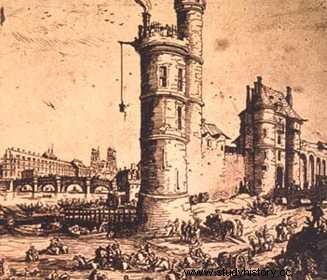
The tower of Nesles
The last direct Capetians
- The reign of Louis X :After the condemnation of the beautiful daughters of the Iron King, his sons still have no direct heir. On the death of Philippe le Bel, Louis X le Hutin (so nicknamed because of his difficult character) succeeded him. This king only reigns for two years. Influenced by his uncle Charles de Valois, he returned prerogatives to the vassals, previously confiscated by his father. He also broke with his father's lawyers, and even went so far as to execute Enguerrand de Marigny, faithful financial adviser to Philippe le Bel. His corpse will be exposed to the gibbet of Paris for two years. He died in 1316 suspiciously. Pregnant, his new wife gives birth to John I, a posthumous child who dies after a few days.
- The reign of Philip V :On the death of Louis, his younger brother Philippe V le Long succeeded him. He claims an erroneous interpretation of the Salic law of the francs which prohibits the daughter of Louis X, Jeanne II of Navarre from wearing the crown. He leaves a law that prevents the fragmentation of the domain between the children of the king.
- The reign of Charles IV :On the death of Philippe V, the latter having had no son, the crown passes to his brother Charles IV le Bel. His reign is influenced by the leader of the vassals, Charles de Valois, his uncle. The latter laid siege to Guyenne to the English. For the first time cannons are used. On the death of Charles IV, the sovereign still had no son. His wife is pregnant, but to everyone's chagrin, she gives birth to a girl.
Coronation of Louis X le Hutin
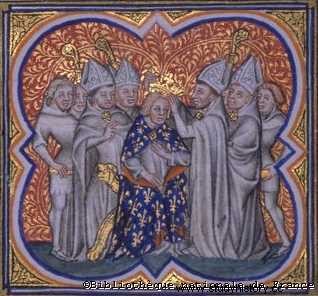
(National Library of France)
The future of the kingdom
For the first time, a serious problem of succession arises. The Capetian dynasty has no direct heir. Is it the curse of the Templars that condemned the French sovereigns? The kingdom of France, so large, so prosperous, so populated, is now going through a serious identity crisis. This problem of succession will serve as a pretext for the Hundred Years War, which will tear the country apart. In the meantime, we must find a king!
